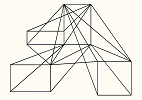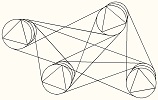


 |
 |
 |
|
Graduate Research Endotrophic Sporulation by the Yeast Nadsonia fulvescens Gary E. Novak Novak, G. E. 1981. Endotrophic Sporulation by the yeast Nadsonia fulvescens. Can. J. Microbiol. 27: 967-970. Abstract Introduction Spores of Nadsonia fulvescens are generally found on solid dextrose-containing growth medium after the culture ages for several days. Spores are normally not formed in liquid growth medium; however, if the cells are washed after growth, sporulation can be induced in the liquid medium. This permits the carbon requirements for sporulation by the species to be studied in liquid medium. An unexpected appearance of spores in the absence of an exogenous carbon source demonstrated endotrophic sporulation which was not previously known to occur with yeasts. Materials and Methods The basic sporulation medium consisted of 0.05M potassium phthalate buffer containing sodium hydroxide for adjusting the pH. Generally, sporulation medium was adjusted to pH 7; but in some cases a comparison was made at pH 5 or 6. Carbon sources were added using sterile stock solutions at 10 times their final concentrations. All solutions entering the culture media were sterilized by autoclaving at 121°C for 15 min, except pyridoxine, which was sterilized by membrane filtration at 100 times the concentration employed in the medium. Dextrose was used at a concentration of 0.5% in growth and sporulation media to minimize the accumulation of ethanol. Ethanol was used at a concentration of 1% in the growth medium. Cells were grown in 100-mL batches in 500-mL Erlenmeyer flasks at an ambient room temperature of 23°C and aerated on a rotary shaker. Growth cultures were inoculated to an initial cell concentration of 5 x 104 cells/mL. Logarithmic-phase cells were harvested at an optical density of 1.0. Stationary-phase cells were harvested at 40 h of growth. Optical densities of cells suspensions were measured at 540 nm. Prior to optical density readings, cell suspensions were sonicated for 10 s with a Bronwill Biosonic (Power 25, tune 3) to eliminate clumping of cells. sonicated cells were discarded after the optical density was recorded. Growth progressed from at least 20 generations and three serial transfers into presporulation medium (growth medium) before the cells were harvested for sporulation or respirometry. Cells were harvested by centrifugation at 2000 x g for 12 min, washed twice in phthalate buffer at pH 6, and resuspended in sporulation medium at a density of 1.0 x 107 cells/mL. This suspension was placed in 50-mL Erlenmeyer flasks (10 mL/flask) and aerated as above. During washing, 1 h elapsed before cells were placed on the shaker or in the respirometer. Generally, each presporulation condition consisted of a single growth flask for those cells which were placed in sporulation media at pH 7, and a second growth flask for the remaining cells. However, where pH 7 was compared with pH 6 or 5, these cells were all derived from the second growth flask. Sporulation counts were made microscopically using phase-contrast optics, counting whole fields and without using stains. The percent asci was determined relative to the total counts of cells, buds and asci with a total of at least 500 being counted in each determination. Sporangia (which were distinguished from the cells on the basis of reduced refractivity) and cells growing out from the sporangia were not counted. In some instances, dilute HCL was added to the slides to disperse clumps prior to counting. Respiration measurements were made at 23°C with air as th gas phase using conventional manometric techniques (Umbreit et al. 1957). In calculating respiratory quotients (Qo2 Values) endogenous respiration (oxygen uptake in buffer alone) was subtracted from measured values. Results and Discussion Ethanol-grown cells were highly predisposed to sporulation in buffer or distilled water, while dextrose grown cells required a carbon source for sporulation (Table 1). (The buffer is not considered to be a metabolizable carbon source, as it does not support growth or sporulation where a carbon source is required.) Sporulation did not occur in acetate medium under any of the conditions studied. Acetate was, in fact, inhibitory to sporulation, since ethanol-grown cells formed spores under all conditions except in the presence of acetate.
Log-phase, dextrose grown cells showed a reduce respiratory capacity as indicated by an inability to oxidize acetate (Table 2) and by a need for a trace of dextrose for effective utilization of ethanol for sporulation (Table 1). The latter phenomenon was related to respiratory capacity by Croes (1967b) in studies of S. cerevisiae. The inhibitory effect of acetate upon sporulation was not due to an inability to oxidize acetate, since the stationary-phase cells and ethanol-grown cells did oxidize acetate (Table 2). It therefore appears that acetate inhibits sporulation through transcriptional repression. Otherwise, the metabolism of acetate as an energy yielding and nonassimilable carbon source should have stimulated sporulation, as suggested for S. cerevisiae (Croes 1967b) and for his species in the next paragraph. While exogenous repressor substances are not known to control sporulation with other species of yeast, the physiology of sporulation of species other than S. cerevisiae has not been studied to any significant extent. TABLE 2. Respiratory capacity of the cells
The high potential of ethanol-grown cells to form spores appears to be due to their slow growth rate. Assimilation of ethanol was apparently encumbered by the lack of a glyoxylate cycle, as indicated by an inability of the cells to grow on acetate, although acetate could be oxidized. Energy-yielding capacity was high with ethanol, as indicated by the respiratory quotients. Since much energy could be produced and little could be used for assimilation, there was probably a large amount of energy stored as lipid and possible in some of the intermediate metabolite pools. Those endogenous energy sources may have predisposed the ethanol-grown cells to endotrophic sporulation. The partial inhibition of sporulation by the basal growth medium appears to be due to availability of assimilable nitrogen, since the inhibition was greater in the presence of a carbon source than in the absence of a carbon source, where the comparison can be made (ethanol-grown cells) (Table 1). The carbon source along with the nitrogen would allow assimilation to occur. Assimilation would reduce energy availability, again indicating that sporulation is dependent upon the energy level in the cells. Croes, A, F. 1967a. Induction of meiosis in yeast. I. Timing of cytological and biochemical events. Planta. 76:209-226. —1967b. Induction of meiosis in yeast. II. Metabolic factors leading to meiosis. Planta 76: 227-237. Esposito, M. S., R. E. Esposito, M. Urnaud, and H. O. Halvorson. 1969. Acetate utilization and macromolecule synthesis during sporulation of yeast. J. Bacteriol. 100: 180-186. Phaff, H. J. 1970. Nadsonia Sydow. In The Yeasts. Edited by J. Lodder. North-Holland Publishing Co., Amsterdam, The Netherlands. pp. 430-439. Umbreit, W. M., W. W. R. Burris, and J. F. Stauffer. 1957. Manometric Techniques. Burgess Publishing Co., Minneapolis, MN. Wickerham, L. J. 1951. Taxonomy of Yeasts. U.S. Dep. Agric. Tech. Bull. No. 1029.
|
|||||||||||||||||||||||||||||||||||||||||||||||||||||||||||||||||||||||||||||||||||||||||||||||||||||||||||||||||||||||||||||||||||||||||||||||||||||||||||||||||||||||||||||||||||||||||||||||||||||||||||||||||||||||||||||||||||||||||||||||||||||||||||||||||||||||||||||||||||||||